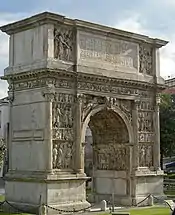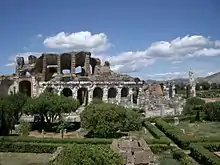Sinuessa
Sinuessa (Greek: Σινούεσσα or Σινόεσσα) was a city of Latium, in the more extended sense of the name, situated on the Tyrrhenian Sea, about 10 km north of the mouth of the Volturno River (the ancient Vulturnus). It was on the line of the Via Appia, and was the last place where that great highroad touched on the sea-coast.[1] The ruins of the city are located in the modern-day municipality of Mondragone, Campania, Italy.
History
It is certain that Sinuessa was not an ancient city; indeed there is no trace of the existence of an Italic town on the spot before the foundation of the Roman colony. Some authors[2] mention an obscure tradition that there had previously been a Greek city on the spot called "Sinope"; but little value can be attached to this statement.It is certain that if it ever existed, it had wholly disappeared, and the site was included in the territory of the Ausonian. The cities belonging to the league were Ausona, Vescia, Minturnae, Sinuessa and Suessa. However, there are various controversies about location and belonging.
During the Latin war the cities of the league, like the Volsci and Campani, supported the Latins against Rome and their Samnite allies. The war, fought between 340 BC and 338 BC, ended with the victory of the Romans. The cities of the League fought again against Rome during the Second Samnite War which began in 326 BC. In 314 BC. the Romans won the cities of the League which were completely destroyed, but later founded the colonies of Sessa Aurunca and Minturnae, cities that retained the name and almost the position of those of the Aurunci.
Sinuessa seems to have rapidly risen into a place of importance; but its territory was severely ravaged in 217 BCE by Hannibal, whose cavalry carried their devastations up to the very gates of the town.[3] It subsequently endeavored, in common with Minturnae and other coloniae maritimae, to establish its exemption from furnishing military levies; but this was overruled, while there was an enemy with an army in Italy. At a later period (191 BCE) Sinuessa again attempted, but with equal ill success, to procure a similar exemption from the naval service.[4] Its position on the Appian Way doubtless contributed greatly to the prosperity of Sinuessa; for the same reason it is frequently incidentally mentioned by Cicero, and we learn that Julius Caesar halted there for a night on his way from Brundisium to Rome, in 49 BCE.[5] It is noticed also by Horace on his journey to Brundusium, as the place where he met with his friends Varius and Virgil.[6]
The fertility of its territory, and especially of the neighbouring ridge of the Mons Massicus, so celebrated for its wines, must also have tended to promote the prosperity of Sinuessa, but we hear little of it under the Roman Empire. It received a body of military colonists, apparently under the Triumvirate,[7] but did not retain the rank of a colonia and is termed by Pliny as well as the Liber Coloniarum only an oppidum, or ordinary municipal town.[8] It was the furthest town in Latium, as that geographical term was understood in the days of Strabo and Pliny, or Latium adjectum, as the latter author terms it; and its territory extended to the river Savo, which formed the limit between Latium and Campania.[9] At an earlier period indeed Polybius reckoned it a town of Campania, and Ptolemy follows the same classification, as he makes the Liris the southern limit of Latium;[10] but the division adopted by Strabo and Pliny is probably the most correct. The Itineraries all notice Sinuessa as a still existing town on the Appian Way, and place it nine miles from Minturnae, which is, however, considerably short of the true distance.[11] In his Meditations, written around AD 180, the emperor Marcus Aurelius notes that his friend Junius Rusticus sent a letter to Marcus's mother from Sinuessa. The period of its destruction is unknown.
Ruins
The ruins of Sinuessa are still visible on the seacoast of Mons_Massicus .(Baia Azzurra) - (Levagnole) is part of the municipality of Sessa Aurunca, in the province of Caserta, in the Campania region. The village of Baia Azzurra - Levagnole is 12.56 kilometers from the same town of Sessa Aurunca to which it belongs).The most important are those of an aqueduct, and of an edifice which appears to have been a triumphal arch; but the whole plain is covered with fragments of ancient buildings.[12]
Baths
At a short distance from Sinuessa were the baths or thermal springs called Aquae Sinuessanae which appear to have enjoyed a great reputation among the Romans. Pliny tells us they were esteemed a remedy for barrenness in women and for insanity in men. They are already mentioned by Livy as early as the Second Punic War; and though their fame was eclipsed at a later period by those of Baiae and other fashionable watering-places, they still continued in use under the Empire, and were resorted to among others by the emperor Claudius.[13] It was there, also, that the infamous Tigellinus was compelled to put an end to his own life.[14] The mild and warm climate of Sinuessa is extolled by some writers as contributing to the effect of the waters (Tacitus Annals xii. 66); hence it is called Sinuessa tepens by Silius Italicus, and mollis Sinuessa by Martial.[15] The site of the waters is still called I Bagni, and the remains of Roman buildings still exist there.
In popular culture
In the Starz series Spartacus: War of the Damned, Spartacus and his rebel army invade and take Sinuessa during the second episode, "Wolves at the Gate", and hold it in subsequent episodes.
Notes
- Strabo v. p. 233.
- Livy x. 21; Pliny the Elder iii. 5. s. 9.)
- Livy xxii. 13, 14.
- Livy xxvii. 38, xxxvi. 3.
- Cicero Epistulae ad Atticum ix. 1. 5, 16, xiv. 8, Familiar Letters xii. 20.
- Sat. i. 5. 40.
- Liber Coloniarum p. 237.
- Pliny iii. 5. s. 9; Lib. Col. l. c..
- Strabo v. pp. 219, 231, 233; Pliny iii. 5. s. 9; Mel. ii. 4. § 9.
- Polybius iii. 91; Ptolomy iii. 1. § 6).
- Antonine Itinerary § 108; Itin. Hier. § 611; Tabula Peutingeriana.
- Cluver. Ital. p. 1080; Romanelli, vol. iii. p. 486.
- Livy xxii. 13; Tacitus Ann. xii. 66; Pliny xxxi. 2. s. 4.
- Tacitus Hist. i. 72; Plutarch Otho 2.
- Silius Italicus viii. 528; Martial vi. 42.
References
 This article incorporates text from a publication now in the public domain: Smith, William, ed. (1854–1857). "Sinuessa". Dictionary of Greek and Roman Geography. London: John Murray. (online version)
This article incorporates text from a publication now in the public domain: Smith, William, ed. (1854–1857). "Sinuessa". Dictionary of Greek and Roman Geography. London: John Murray. (online version)


